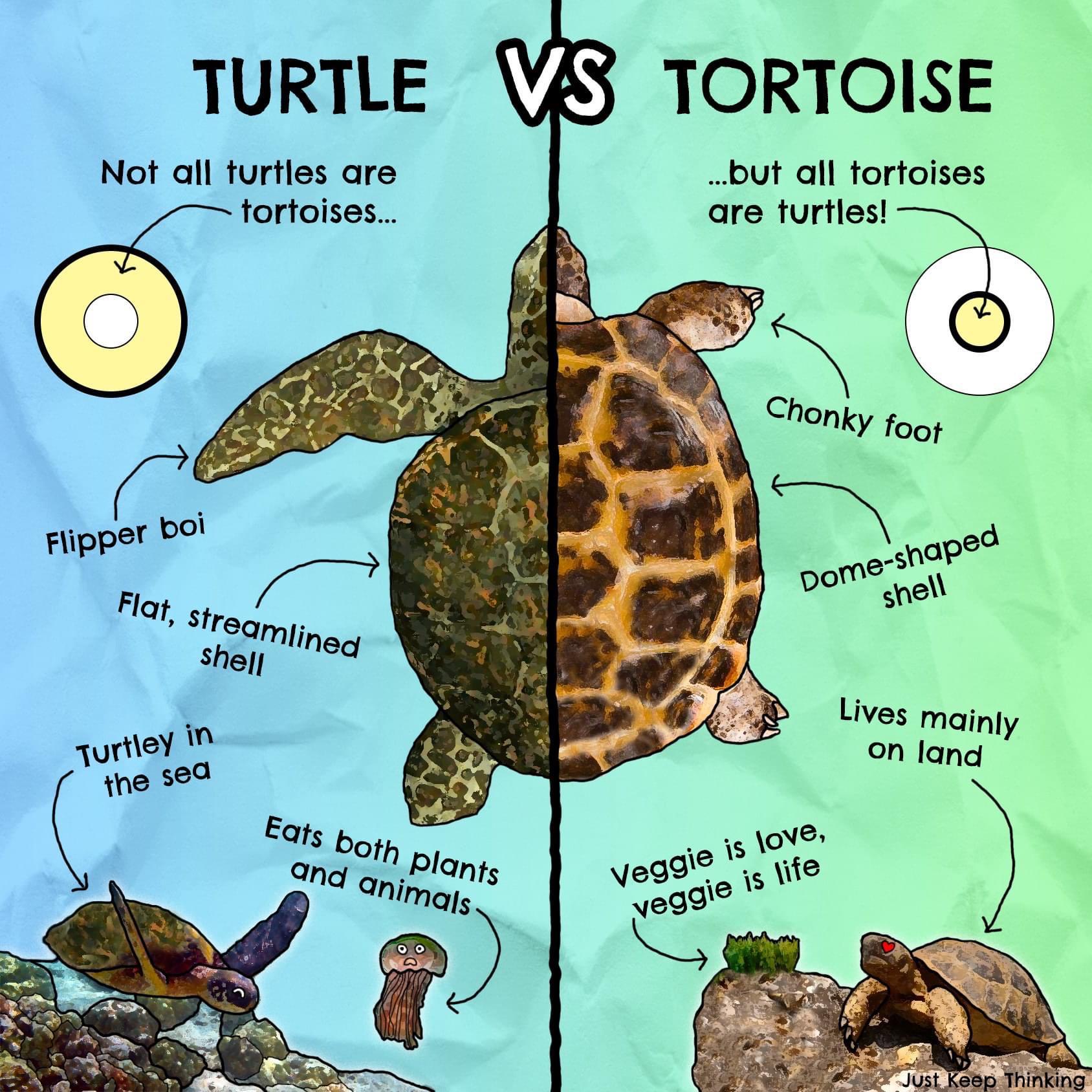No, not all tortoises are turtles. Tortoises are a type of turtle, but there are other types as well.
Tortoises and turtles are often confused, but they are not the same. While tortoises are a specific type of turtle, there are other types such as sea turtles and freshwater turtles. Tortoises are land-dwelling reptiles with a dome-shaped shell, short and sturdy limbs, and a herbivorous diet.
They are adapted for life on land and generally live in dry environments. On the other hand, turtles are a broad category that includes both tortoises and various aquatic species. They have flatter shells, webbed feet or flippers for swimming, and a diet that can include both plants and other animals. So, while all tortoises are turtles, not all turtles are tortoises.

Credit: www.britannica.com
Characteristics Of Tortoises
Tortoises have unique characteristics that differentiate them from turtles. While all tortoises are turtles, not all turtles are tortoises. Tortoises are known for their dome-shaped shells, land-dwelling nature, and their ability to retract their heads into their shells for protection.
They are herbivores and can be found in various parts of the world, adapting to different climates and habitats.
Shell And Body Structure
Tortoises are known for their unique shell and body structure. They have a sturdy, dome-shaped shell that provides them with excellent protection. The shell is made up of two parts – the carapace on the top and the plastron on the bottom. This hard outer covering is fused to the tortoise’s backbone and ribs, providing it with a natural shield against predators. Additionally, their bodies are adapted to life on land, with strong limbs and feet specifically designed for walking on solid ground. These characteristics distinguish tortoises from other turtles that may have flatter shells or more aquatic adaptations.
Habitat And Behavior
Tortoises primarily inhabit land environments, such as deserts, grasslands, and forests. They are terrestrial creatures, spending most of their time on dry land rather than in water. Unlike turtles, they are not adapted for swimming and have limited mobility in water. Tortoises are generally solitary animals, preferring to live alone rather than in groups. They establish territories and can defend themselves against potential threats using their strong shells and powerful bites.
Diet And Feeding Habits
Tortoises are herbivorous, meaning they primarily feed on plants. Their diet consists of various vegetation, such as grass, leaves, flowers, and fruits. They have a strong beak that allows them to graze on tough plant material, and their digestive systems are well-adapted to efficiently break down the fibrous components of their diet. Tortoises are diurnal creatures, meaning they are most active during the day and spend their time grazing and finding food sources.

Credit: animals.howstuffworks.com
Characteristics Of Turtles
Tortoises and turtles are two different species, with tortoises being land-dwelling reptiles and turtles being aquatic. Although they share some similarities, such as the protective shell and slower movements, not all tortoises are turtles.
| Shell and Body Structure | Turtles and tortoises are reptiles that share certain physical characteristics. Both have a bony shell, where the turtle’s shell is more streamlined for swimming while the tortoise’s shell is dome-shaped and more land-adapted. The shell is formed by fused ribs and vertebrae, providing protection and support. |
|---|---|
| Habitat and Behavior | Turtles can be found in various habitats, such as oceans, rivers, swamps, and even deserts. They are known for their ability to retract their limbs into their shells for protection. Tortoises, on the other hand, are typically found in terrestrial environments like grasslands and forests. They are generally slower and spend most of their time on land. |
| Diet and Feeding Habits | Turtles and tortoises have differing diets. Turtles are omnivorous and often feed on a combination of plants, insects, fish, and small aquatic creatures. Tortoises, on the other hand, are herbivores and primarily eat vegetation such as grasses, leaves, and cacti. Their jaws are adapted for grinding and slicing plant matter. |
Comparison And Distinction
| Physical Differences | Habitat Differences | Behavior and Feeding Differences |
|---|---|---|
| Tortoises have a dome-shaped, heavy shell designed for protection. | Tortoises are primarily terrestrial and prefer dry habitats like deserts and grasslands. | Tortoises are herbivores and have specialized diets consisting of plants and vegetation. |
| Turtles have a more streamlined, lightweight shell adapted for aquatic environments. | Turtles are aquatic and inhabit various water bodies such as oceans, lakes, and rivers. | Turtles have a diverse diet and can be omnivores or carnivores depending on the species. |
Physical Differences: Tortoises have a dome-shaped, heavy shell designed for protection, while turtles have a more streamlined, lightweight shell adapted for aquatic environments.
Habitat Differences: Tortoises are primarily terrestrial and prefer dry habitats like deserts and grasslands, whereas turtles are aquatic and inhabit various water bodies such as oceans, lakes, and rivers.
Behavior and Feeding Differences: Tortoises are herbivores and have specialized diets consisting of plants and vegetation, while turtles have a diverse diet and can be omnivores or carnivores depending on the species.

Credit: www.nashvillezoo.org
Conclusion
All tortoises are not turtles, but all turtles are indeed tortoises. Understanding the distinction between these two reptiles is crucial for both pet owners and wildlife enthusiasts. By recognizing their unique characteristics and habitats, we can appreciate the diverse world of these ancient creatures.
So, next time you encounter a tortoise or a turtle, remember, they may look similar, but their differences are worth exploring.





Leave a Reply